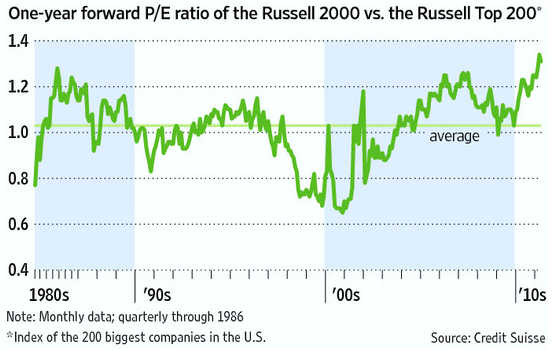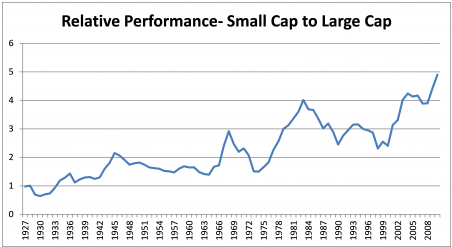The rise for small cap stocks, as measured by the
Russell 2000 small cap index, have handily outpaced gains of large cap
indices by over 50 percent since the March 2009 lows. The significant
rise in the index and high valuations today show that now may be an
opportune time to consider reducing overall exposure to small cap
stocks.
While the jump in price of small caps as an asset
class has been significant, it is unlikely to continue indefinitely. For
this reason, we are now entering a phase of time when individual stock
picking talent will be put to the test.
The major market benchmarks have been on a tear over the past two years. Since the bull market began in March 2009, the Russell surged 144 percent while the Dow and S&P 500 advanced 89 percent and 95 percent, respectively.
Today, the Russell 2000 small cap index is just
two percent below its record high of June 29, 2007. Meanwhile, the other
major market benchmarks including the Dow and S&P 500 remain 12
percent and 14 percent off their all time highs.
After such a significant advance, investors should
begin to question whether the rise of small cap stocks and their current
valuations are sustainable.
***There is no doubt that by historical standards,
small cap valuations are now stretched and likely entering a period of
underperformance compared to mid and large cap stocks.
Based on price-to-earnings ratios, small cap
stocks currently trade at the largest premium compared to large caps
since 1979. The Russell 2000 is trading at almost 18 times one-year
forward forecast earnings,
reports Jonathan Cheng of the Wall Street Journal.
If we compare the forward PE of Russell 2000 with
the forward PE of the 200 largest companies in the U.S., the small caps
have never been this expensive:

The relative valuation of the S&P 500 large
cap index compared to the S&P 600 small cap also provides the same
picture as the chart above, with the large caps trading at just
13.7-times earnings versus a multiple of 19-times earnings for small
caps.
When small caps trade at such a rich valuation, it
often points to a pullback on the horizon. Valuations of small caps
reached similar levels twice in the past, back in 1983 and 2007. In both
instances, small caps started to underperform the mid and large cap asset
classes. You can see the relative performance chart of small caps versus
large caps stocks below.
Not only have the gains for small caps outpaced
larger stocks and valuations are high, but there are other concerns on
the horizon.
***As you're well aware, the bull market recently celebrated its second anniversary. I suspect your portfolio, like mine, has been profiting handsomely over the last two years. But the fact that we're now two years into this bull market means that the rise for stocks may be coming to an end soon.
Over the past century there have been thirty-three
bull markets with an average lifespan of 2.1 years. Only fourteen lasted
over two years, and of those, only two have witnessed gains greater than
the advance off the March 2009 lows. From this perspective, it stands to
reason that the current bull market could be nearing its peak and running
out of steam.
With small caps getting ahead of themselves, and
the market in general appearing to be approaching the end of its recovery
from the lows, what should individual investors be doing?
Investors may want to consider reducing broad
exposure to small caps in index funds or mutual funds, and look to
replace some of these holdings with investments in more attractively
valued mid or large cap stocks. Additionally, they may want to consider
focusing on individual stocks that offer attractive growth and trade at
decent valuations.
It's a Stock Picker's
Market
***In periods of time when stocks have been rising
without fail, investor's can do very well by investing in index funds
through Exchange Traded Funds (ETFs) or mutual funds with exposure to
certain asset classes. Investors who have owned small-caps through an ETF
like the iShares Russell 2000 IWM have reaped significant profits
in the past two years.
However, with small caps trading at rich
valuations, now isn't the time to be buying an index fund. Instead, times
like this point to the importance of stock picking and finding the
individual small cap stocks that are hidden gems.
Now is the time to perform thorough and extensive
research. As always, I will be on the constant search for the best small
cap stocks that have been overlooked by other investors and analysts. It
is my job to present you with small cap companies that have attractive
valuations that will grow more quickly than their
counterparts.
Long-term readers know that I have an impeccable track record picking stocks in the Small Cap Investor Pro email newsletter.
Here are a few of best performing picks:
- True Religion TRLG +2,216%
- Investools SWIM +561%
- Nuance (NAUN) +276%
Individual investors can profit by purchasing
shares of the best small cap companies at the right time. In spite of the
rise of small cap stocks, my team of analysts at Wyatt Investment
Research continues to find attractive investments worthy of your
consideration. My SmallCapInvestor PRO service has a history of
finding the best small cap stocks poised for big gains in the coming
years.
I invite you to consider
trying my service absolutely risk-free for 30 days by clicking here
now.
Remember, over the long-term small cap stocks outperform all other classes of equities, and for this reason, it always makes sense to have a portion of your portfolio allocated to small caps.
© 2024 Benzinga.com. Benzinga does not provide investment advice. All rights reserved.
Comments
Trade confidently with insights and alerts from analyst ratings, free reports and breaking news that affects the stocks you care about.
